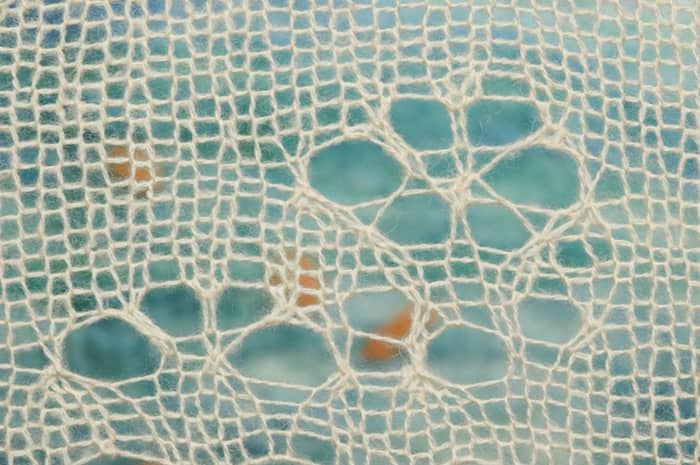
Contemplative Window I (detail), wool yarn, felted wool, wood, 49 x 46 x 6 inches, photo by Paul Rogers, Stowe VT © 2005 Eve Jacobs-Carnahan
Felted Wool Textures in Artwork
When I design and plan my artwork, I think about the textures of the surfaces. Different textures create different visual effects. Felted wool creates a fuzzy texture that blurs lines and transitions between colors in the fabric. When juxtaposed with knitted lace, the contrast highlights the crisp lines of the lace, which in turn emphasizes the hazy appearance of the felt. You can see this contrast in the photo showing a close-up of Contemplative Window II above.
Felting makes fabric without tools
Felting is an ancient method of making fabric without any tools. It’s much simpler than weaving or knitting. Most fibers from animals felt eventually, though the speed of felting different fibers varies. Animal fibers have microscopic barbs along their shafts. When you felt the fiber, the barbs catch hold of each other and fuse the fibers together. I had a pair of angora mittens that felted simply from the friction of my sweaty hands while wearing them. (Angora items are very warm, that’s why my hands got sweaty.)
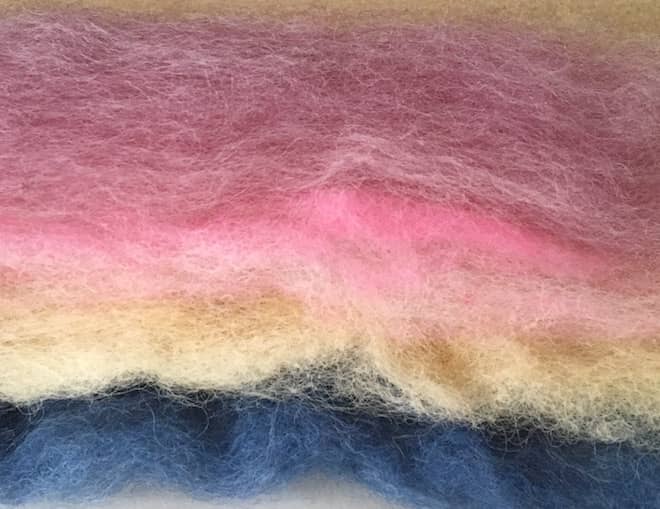
Layers of carded wool batts ready to use in felting. Photo by Eve Jacobs-Carnahan.
As my angora mitten experience shows, felting requires heat, friction, and moisture. It’s a simple process to wet down layers of carded wool with hot soapy water that you rub and roll, purposely matting the wool. Depending on the type of wool, the thickness of the layers, and how long it’s manipulated, the result can be thin and gauzy or strong and firm. There are lots of articles and video tutorials on making felt, such as this one.
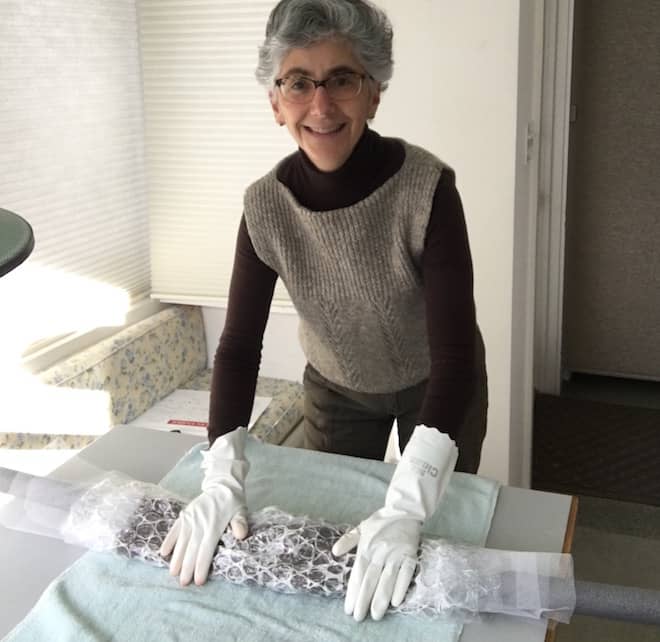
Artist Eve Jacobs-Carnahan rolling wet wool to make felt. Photo by Eve Jacobs-Carnahan.
All that rubbing moves the fibers around, so there is a certain amount of serendipity with felting. Even if you arrange colors of wool to create a pattern or design, it’s almost guaranteed the colors will shift position during felting.
When I want shapes to stay in place, I use felting needles. These sharp barbed needles are the same tool that industrial felting machines use. Jabbing the needle up and down through layers of wool, catches barbs from one layer onto fibers in another layer. Industrial machines use thousands of needles moving at high speed to felt wool or synthetic material.
Felting for textural contrast in artwork
In my 3-part series of Contemplative Windows, I wanted to give the impression of looking through a window to a distant image. Felting was the perfect technique for creating an indistinct scene.
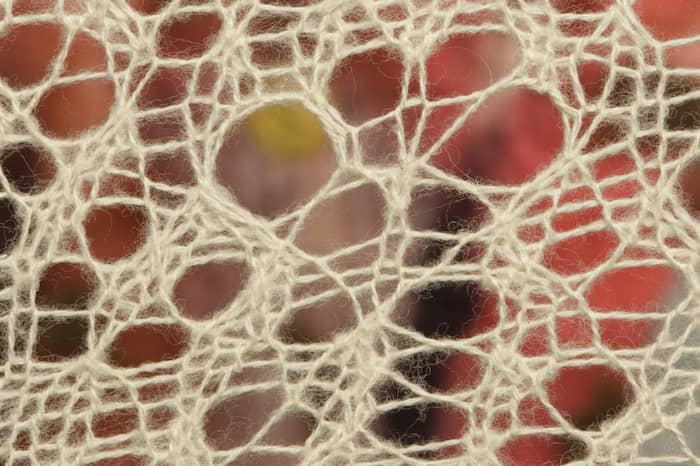
Contemplative Window II (detail), wool yarn, felted wool, wood, 49 x 46 x 6 inches, photo by Paul Rogers, Stowe VT © 2005 Eve Jacobs-Carnahan
The red window, Contemplative Window II, was inspired by the stained glass windows at Sainte-Chappelle in Paris, which I visited many years ago. I still remember being mesmerized by the intense colors and soaring light-filled space of that church. The stone buttresses support the building from the outside so the columns that frame the windows practically disappear. You can get a good sense in this short video tour of this Gothic architectural masterpiece with travel writer Rick Steves.
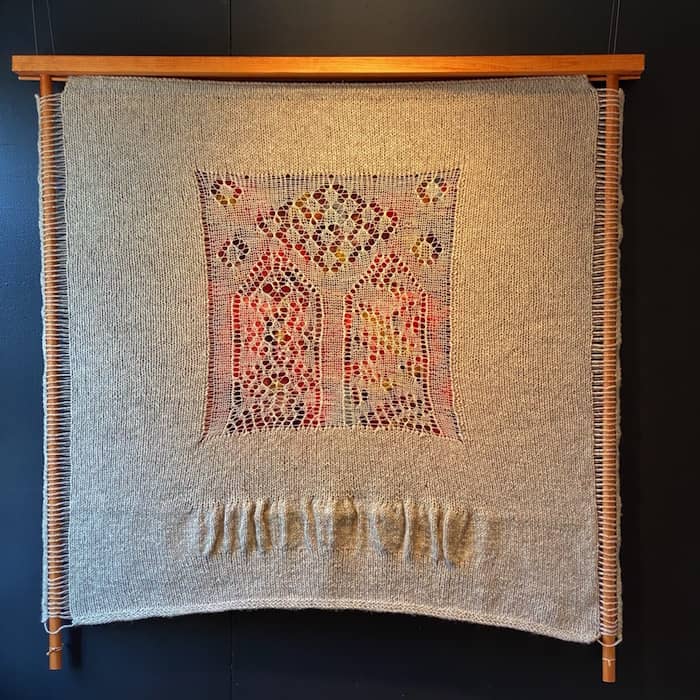
Contemplative Window II, wool yarn, felted wool, wood, 49 x 46 x 6 inches, photo by the artist, © 2005 Eve Jacobs-Carnahan
Displayed on a black wall at the Grange Hall Cultural Center, Waterbury, VT, in 2020 and lit from above, the piece seems to glow from within.
There are really four textures at play in this piece. (Five if you count the wood frame.) The felt is the most indistinct with its fuzzy halo of fibers. The lace is the sharpest; its thin lines drawing patterns against the colorful background of felt. Two others are created by the firm grey wool yarn. I chose this yarn from Green Mountain Spinnery because it resembled stone. Knit in a plain stockinette stitch, it creates a smooth even surface that sets off the other textures. The last comes from the pleated stich pattern in the bottom portion of the grey panel. By knitting undulations into the fabric I created the illusion of heavy columns of stone. It provides another contrast to the ethereal lace.
Creating calm and serenity in felt

Contemplative Window I, wool yarn, felted wool, wood, 49 x 46 x 6 inches, photo by Paul Rogers, Stowe VT © 2005 Eve Jacobs-Carnahan
The theme of the blue window is water. I felted shades of blue wool into a gradient transition from light to dark. I imagined looking into a deep pool of water, but not being able to make out what’s there.
The water is calm and serene, reflecting the sky and clouds. Those orange spots suggest brightly colored fish or leaves that have fallen in the pool. Scattered on top are lace raindrops creating ripples on the water’s surface. There is very little movement in this piece. The lace droplets convey stillness and tranquility. Captured in felted wool.
I wrote about the Contemplative Windows and other works that employ layers for visual effect in this post: Lace, Layers, and Looking.
Beautiful, initmate and evocative pieces!
Thank you, Christine. I’m glad the pieces spoke to you, especially because I admire your work so much!